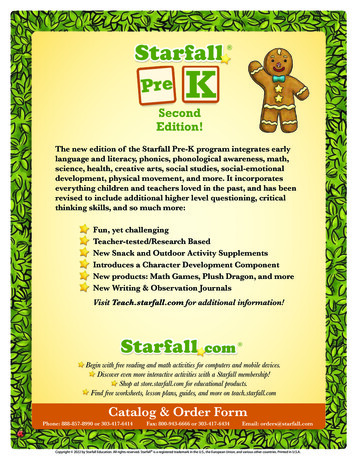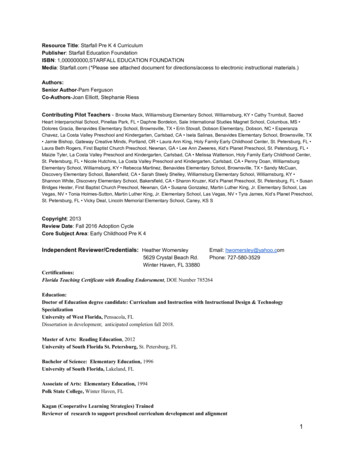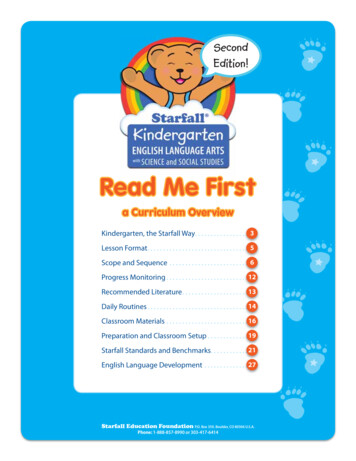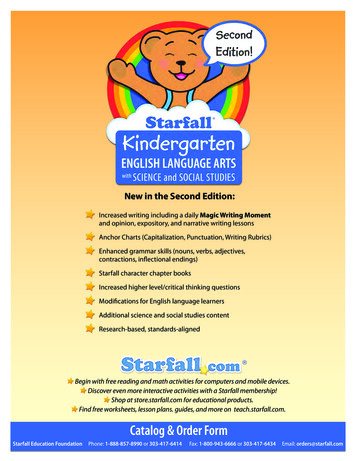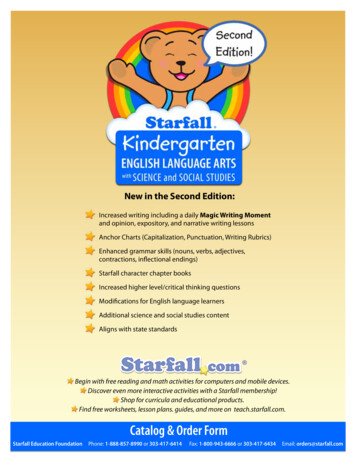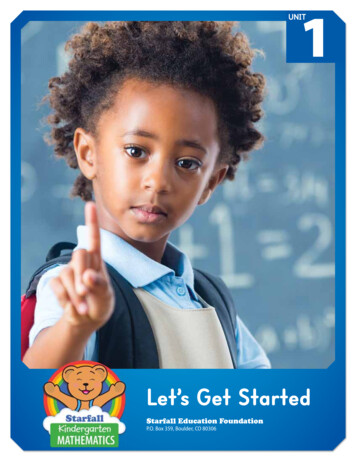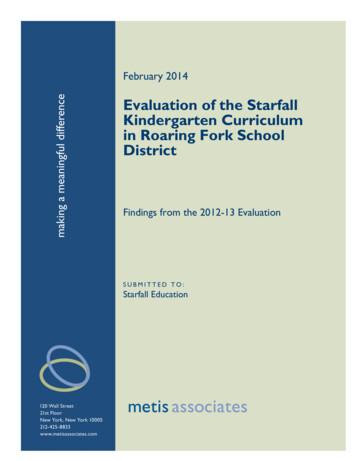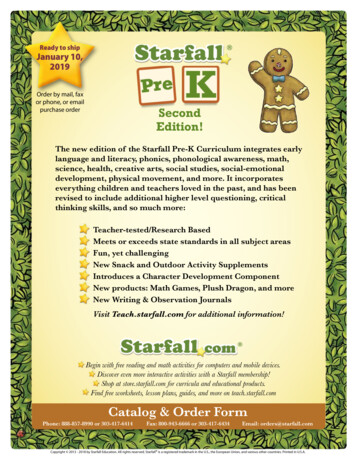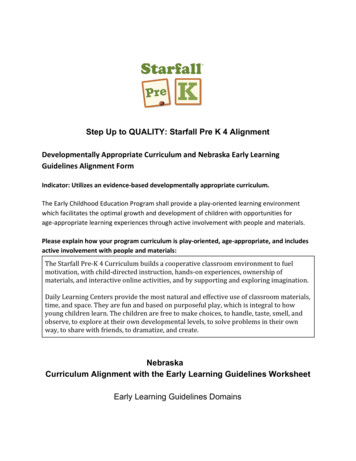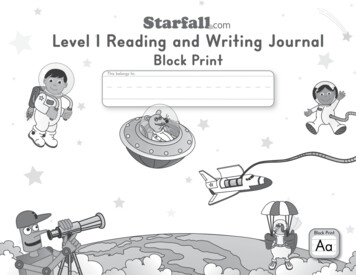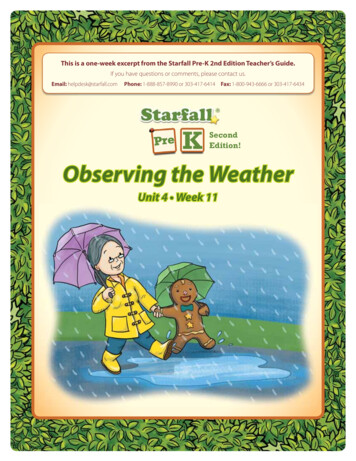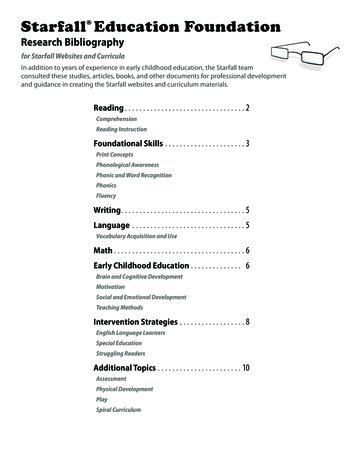
Transcription
Starfall Education FoundationResearch Bibliographyfor Starfall Websites and CurriculaIn addition to years of experience in early childhood education, the Starfall teamconsulted these studies, articles, books, and other documents for professional developmentand guidance in creating the Starfall websites and curriculum materials.Reading . . . . . . . . . . . . . . . . . . . . . . . . . . . . . . . . 2ComprehensionReading InstructionFoundational Skills . . . . . . . . . . . . . . . . . . . . . 3Print ConceptsPhonological AwarenessPhonic and Word RecognitionPhonicsFluencyWriting . . . . . . . . . . . . . . . . . . . . . . . . . . . . . . . . . 5Language . . . . . . . . . . . . . . . . . . . . . . . . . . . . . . . 5Vocabulary Acquisition and UseMath . . . . . . . . . . . . . . . . . . . . . . . . . . . . . . . . . . . 6Early Childhood Education . . . . . . . . . . . . . . 6Brain and Cognitive DevelopmentMotivationSocial and Emotional DevelopmentTeaching MethodsIntervention Strategies . . . . . . . . . . . . . . . . . . 8English Language LearnersSpecial EducationStruggling ReadersAdditional Topics . . . . . . . . . . . . . . . . . . . . . . . 10AssessmentPhysical DevelopmentPlaySpiral Curriculum
ReadingComprehensionBeck, I. L., M. G. McKeown, C. Sandora, L. Kucan, and J. Worthy (1996). Questioning the author: A year-longclassroom implementation to engage students with text. Elementary School Journal, 96:385–414.Beck, I. L., M. G. McKeown, R. L. Hamilton, and L. Kucan (1997). Questioning the Author: An Approach forEnhancing Student Engagement with Text. Newark, DE: International Reading Association.Beck, I. L., M. G. McKeown, R. Hamilton, and L. Kucan (1998). Getting at the meaning: How to helpstudents unpack difficult text. American Educator, 22:66–85.Berthoff, A. E. (1984). Recognition, representation, and revision. In R. L. Graves, ed., Rhetoric andComposition: A Sourcebook for Teachers and Writers. Portsmouth, NH: Boynton/Cook.Cain, Kate, Hugh Catts, Tiffany Hogan, and Richard Lomax. “Learning to Read: Should We Keep ThingsSimple?” Reading Research Quarterly, 50(2) (2015) International Literacy Association: 151-169.Pearson, P. D., L. R. Roehler, J. A. Dole, and G. G. Duffy (1992). Developing expertise in reading comprehension.In S. J. Samuels and A. E. Farstrup, eds., What Research Has to Say About Reading Instruction, 2ndEdition, 145-190. Newark, DE: International Reading Association.Suggate, Sebastian P. PhD. “A Meta-Analysis of the Long-Term Effects of Phonemic Awareness, Phonics,Fluency, and Reading Comprehension Interventions.” Journal of Learning Disabilities Volume 49(2016): 77-96.Reading InstructionArmbruster, Bonnie B, et al. 2003. Put Reading First: The Research Building Blocks of Reading Instruction.Washington, DC: Center for the Improvement of Early Reading Achievement.Gambrell, L. B., L. M. Morrow, and C. Pennington, (2000). Early childhood and elementary literature-basedinstruction: Current perspectives and special issues. In M. L. Kamil, P. B. Mosenthal, P. D. Pearson, andR. Barr, eds., Handbook of Reading Research, Vol. 3.Karen E. Kuhn, Casey M.Rausch, Tiffany T. McCarty, Sarah E. Montgomery, and Audrey C. Rule. “UtilizingNonfiction Text to Enhance Reading Comprehension and Vocabulary in Primary Grades” SpringerScience Business Media New York Published online 31 December 2015: 3-18.National Institute of Child Health and Human Development (2000). Report of the National Reading Panel.Teaching children to read: An evidence-based assessment of the scientific research literature on readingand its implications for reading instruction (NIH Publication No. 00-4769). Washington, DC: U.S.Government Printing Office.National Reading Panel. (2000). Teaching Children to Read: An Evidence-Based Assessment of the ScientificResearch Literature on Reading and Its Implications for Reading Instructions: Reports of the Subgroups.Rockville, MD: National Institute of Child Health and Human Development. Retrieved p/Pages/report.aspx.Ruetzel, D. R., and R. B. Cooter (2003). Strategies for Reading Assessment and Instruction: Helping EveryChild Succeed, 2nd Edition, 32-35. Upper Saddle River, NJ: Merrill Prentice Hall.Ruetzel, D. R., and R. B. Cooter (2005). The Essentials of Teaching Children to Read: What Every TeacherNeeds to Know. Upper Saddle River, NJ: Merrill Prentice Hall.Snow, Catherine E. and Timothy J.Matthews. “Reading and Language in the Early Grades.” The Future ofChildren.org Volume 26 No. 2 (2016): 57-74.Starfall Reading Bibliography 2
Foundational SkillsPrint ConceptsAdams, M. J. (1990). Beginning to Read: Thinking and Learning about Print. Cambridge, MA: MIT Press.Block, Meghan K. and Neil K Duke. “Letter Names Can Cause Confusion and Other Things to KnowAbout Letter-Sound Relationships.” National Association for the Education of Young Children (NAEYC).March 2015: 84-91.Phonological AwarenessAdams, M. J., B. R. Foorman, I. Lundberg, and T. Beeler (1998). The elusive phoneme: Why phonemicawareness is so important and how to help children develop it. American Educator:The Unique Power of Reading and How to Unleash It, 22:18–29.Anthony, J. L., J. M. Williams, R. McDonald, and D. J. Francis (2007). Phonological processing and emergentliteracy in younger and older preschool children. Annals of Dyslexia, 57(2):113-137.Anthony, J. L. and C. J. Lonigan (2004). The nature of phonological awareness: Converging evidence fromfour studies of preschool and early grade school children. Journal of Educational Psychology, 96(1):43-55.Ball, E. W., and B. A. Blachman (1991). Does phoneme awareness training in kindergarten make a differencein early word recognition and developmental spelling? Reading Research Quarterly, 26:49–66.Batson-Magnuson PhD, LuAnn. “An Analysis of the Relationship Between Phonological andNonphonological Language and Early Reading Development.” Communication Disorders Quarterly2017, Volume 38(2): 78-88.Blachman, B. A., E. W. Ball, R. S. Black, and D. M. Tangel (1994). Kindergarten teachers developphoneme awareness in low-income, inner-city classrooms. Reading and Writing:An Interdisciplinary Journal, 6:1–18.Cunningham, A. E. (1990). Explicit versus implicit instruction in phonological awareness.Journal of Experimental Child Psychology, 50:429-444.Falth, Linda Dr, S. Gustafson and I. Svensson. “ Phonological Awareness Training With ArticulationPromotes Early Reading Development.” Education, Volume 137 No. 3 (2017): 261-276.Karimkhanlooeia, Giti and Hadis Seifiniya. “Teaching Alphabet, Reading and Writing for Kids between 3-6Years Old as a Second Language.” Science Direct. Elsevier B.V. 11-14 December 2014.Mahai M.A., Alina, Amber Friesen PhD, Gretchen Butera PhD, Eva Horn PhD, Joan Lieber PhD, and SusanPalmer PhD. Susan “Teaching Phonological Awareness to All Children Through Storybook Reading.”Young Exceptional Children, Volume 18 No. 4, December 2014: pp. 78-88.Pufpaff, Lisa A. (2009). A developmental continuum of phonological sensitivity skills.Psychology in the Schools, 46(7):679-691. Wiley Periodical, Inc.Reese, Elaine, Sarah-Jane Robertson, Sarah Divers, and Elizabeth Schaughency. “Does the brown bananahave a beak? Preschool children’s phonological awareness as a function of parents’ talk about speechsounds.” First Language 2015 Volume 35(1): 54-67.Solveig-Alma Halaas Lyster, Arne Olav Lervag, and Charles Hulme. “Preschool morphological trainingproduces long-term improvements in reading comprehension.” Springerlink.com. Published online17 March 2016.Starfall Foundational Skills Bibliography 3
Stewart, Mark R. (2004). Phonological awareness and bilingual preschoolers: Should we teach it and,if so, how? Early Childhood Education Journal, 32(1):31-37.Suggate, Sebastian P. PhD. “A Meta-Analysis of the Long-Term Effects of Phonemic Awareness, Phonics,Fluency, and Reading Comprehension Interventions.” Journal of Learning Disabilities, Volume 49(2016): pp. 77-96.Wagner, R., and J. Torgesen (1987). The nature of phonological processing and its causal role in theacquisition of reading skills. Psychological Bulletin, 101:192-212.Phonic and Word RecognitionKirby, John R., S. Helene Deacon, Peter N. Bowers, Leah Izenberg, Lesly Wade-Woolley, and Rauno Parrila.“Children’s morphological awareness and reading ability.” Springer Science Business Media B.V.Published online 25 March 2011.Moats, Louisa Cook (2000). Speech to Print: Language Essentials for Teachers. Baltimore, MD: Brookes Publishing.Moats, L. C. (1998). Teaching decoding. American Educator, Spring/Summer.Solveig-Alma Halaas Lyster, Arne Olav Lerva, and Charles Hulme. “Preschool morphological trainingproduces long-term improvements in reading comprehension.” Springerlink.com. Published online17 March 2016.Stahl, S. (1992). Saying the “P” word: Nine guidelines for exemplary phonics instruction.The Reading Teacher, 45:618-625.PhonicsBeck, Isabel L. and Mark E. Beck. Making Sense of Phonics. New York: Guilford Press, 2013Beck, Isabel L. and Margaret G. McKeown and Linda Kucan. Bringing Words to Life. New York:Guilford Press, 2013Moats, Louisa Cook. Speech to Print. Baltimore: Brookes Publishing, 2010.Suggate, Sebastian, Eva Pufke, and Heidrun Stoeger. “The effect fine and grapho-motor skill demands onpreschoolers’ decoding skill.” Journal of Experimental Child Psychology 141 (2016) 34-48.FluencyMenon, S. and E. H. Hiebert (2005) A comparison of first grader’s reading with little books orliterature-based basal anthologies. Reading Research Quarterly, 40(1):18.Rasinski, T. (1989). Fluency for everyone: Incorporating fluency instruction in the classroom.The Reading Teacher, 42:690-693.Rasinski, Timothy V. (2003). The Fluent Reader. New York, NY: Scholastic.Samuels, S., N. Schermer, and D. Reinking (1992). Reading fluency: Techniques for makingdecoding automatic. In S. Samuels, and A. Farstrup, eds., What Research Has to Say AboutReading Instruction, 2nd Edition.Suggate, Sebastian P. PhD. “A Meta-Analysis of the Long-Term Effects of Phonemic Awareness, Phonics,Fluency, and Reading Comprehension Interventions.” Journal of Learning Disabilities, Volume 49(2016): 77-96. PrintStarfall Foundational Skills Bibliography 4
WritingAdams, M. J., R. Treiman, and M. Pressley (1998). Reading, writing, and literacy. In I. E. Sigel and K. A. Renninger,eds. Handbook of Child Psychology, Fifth Edition, Vol. 4, Child Psychology in Practice, 275-355. New York: Wiley.Bay Area Reading Task Force (1997). A Reading-Writing-Language Source Book for the Primary Grades.San Francisco: University School Support for Educational Reform.Bigozzi, Lucia and Giulia Vettori. “To tell a story, to write it: developmental patterns of narrative skills frompreschool to first grade.” Instituto Superior de Psicologia Aplicada, Lisboa, Portugal and SpringerScience Business Media Dordrecht 2015.National Commission on Writing for America’s Families, Schools, and Colleges (2004). Writing: a ticketto work or a ticket out: a survey of business leaders. New York: College Board.Teale, W. and J. Yokota (2000). Beginning reading and writing: Perspectives on instruction. In D. Stricklandand L. Morrow, eds., Beginning Reading and Writing, 3-21.LanguageRatcliff, Nancy, Kimberly Carroll, Emma Savage-Davis, Richard Costner, Cathy Jones, Nicholas Pritchard,and Gilbert Hunt. “Oral Language Usage in Prekindergarten Classrooms.” Education, Volume 137,Number 3: 306-319.Vocabulary Acquisition and UseAlaraj, Mammon M. “Vocabulary-centered Strategy: It’s Effect on Reading Comprehension and Teachers’Opinions Concerning its Utility” Theory and Practice in Language Studies, Vol. 5, No. 9, pp. 1791-1800,September 2015.Allen, L. (1998). An integrated strategies approach: Making word identification instruction work forbeginning readers. The Reading Teacher, 52(3):254–268.American Association of School Librarians and the Association for Educational Communications andTechnology (1998). Information Power: Building Partnerships for Learning.Chicago, IL: American Library Association.Anderson, R. C., and W. E. Nagy (1991). Word Meanings. In R. Barr, M. L. Kamil, P. B. Mosenthal, andP. D. Pearson, eds., Handbook of Reading Research, Vol. 2. New York: Longman.Baker, S. K., D. C. Simmons, and E. J. Kame’enui (1998). Vocabulary acquisition: Research bases. In D. C.Simmons and E. J. Kame’enui, eds., What Reading Research Tells Us About Children with Diverse LearningNeeds. Mahwah, NJ: Lawrence Erlbaum Associates.Barinaga, M. (1996). Giving language skills a boost. Science, 271:27–28.Baumann, J. F., and E. J. Kame’enui, eds. (2004). Vocabulary Instruction: Research to Practice.New York: Guilford Press.Baumann, J. F., and E. J. Kame’enui (1991). Research on vocabulary instruction: Ode to Voltaire. In J. Flood,J. J. D. Lapp, and J. R. Squire, eds., Handbook of Research on Teaching the English Language Arts.New York, NY: Macmillan.Beck, I. L., M. G. McKeown, and L. Kucan (2002). Bringing Words to Life: Robust Vocabulary Instruction.New York: Guilford Press.Biemiller, Andrew (2001). Teaching vocabulary: Early, direct, and sequential.The American Educator, Spring, 25(1):24-28.Starfall Writing, Language Bibliography 5
Blachowicz, C. L. Z., and P. Fisher (1996). Teaching Vocabulary in All Classrooms.Englewood Cliffs, NJ: Merrill/Prentice Hall.Butler, Shari, Kelsi Urrutia, Anneta Buenger, Nina Gonzalez, Marla Hunt, and Corinne Eisenhart. “A Reviewof the Current Research on Vocabulary Instruction.” National Reading Technical Assistance Center, RMCResearch Corporation 2010.Leung, Cynthia B. (2008). Preschooler’s acquisition of scientific vocabulary through repeated read-aloudevents, retellings, and hands-on science activities. Reading Psychology, 29(2):165-193.MathCross, C. T., T. A. Woods, and H. Schweingruber (2009). Mathematics Learning in Early Childhood:Paths Toward Excellence and Equity. Washington, DC: National Academy Press.Dixon, R. C., D. W. Carnine, D-S. Lee, J. Wallin, and D. Chard (1998). Report to the CA State Board of Education andAddendum to Principal Report: Review of High Quality Experimental Mathematics Research. Eugene, OR:National Center to Improve the Tools of Educators, University of Oregon and University of Texas at Austin.Hughes, J. L., A. M. Scott, C. A. McMurry, P. P. Claxton, A. G. McCloskey and T. E. Clarke (1913).Public School Methods, 2:281-322. Chicago, IL: Hanson-Bellows Co.McMurry, C. A., J. E. Black, P. P. Claxton, S. C. Schmucker, W. A. Shoemaker, and others (1912).Public School Methods, 1:204-281. Chicago, IL: Hanson-Bellows Co.Nikiforidou, Zoi, Jenny Pange, and Theodore Chadjipadelis. “Intuitive and Informal Knowledge inPreschoolers’ Development of Probabilistic Thinking.” Springer Science Business Media Dordrecht2013 Published online 23 February 2013.Pollitt, Rache, Caroline Cohrssen, Amelia Church, and Susan Wright. “Thirty-one is a Lot! Assessing fouryear-old children’s number knowledge during an open-ended activity.” Australasian Journal of EarlyChildhood, Volume 40, No. 1 (February 2016): 13-22.Raghubar, Kimberly P. and Marcia A. Barnes. “Early numeracy skills in preschool-aged children: areview of neurocognitive findings and implications for assessment and intervention,” The ClinicalNeuropsychologist, (2017) 31:2, 329-351, DOI: 10.1080/13854046.2016.1259387.Williams, H. G. (1921). Methods of Teaching Arithmetic. In School Methods Publishing Co.,Public School Methods, 2:177-318. Chicago, IL: School Methods Company.Early Childhood EducationBrain and Cognitive DevelopmentBarnett, W. S. (1995.) Long-term effects of early childhood programs on cognitive and school outcomes.The Future of Children, 5(3):25-50.Halfon N, E. Shulman, and M. Hochstein (2001). Brain development in early childhood. In N. Halfon,E. Shulman, and M. Hochstein, eds., Building Community Systems for Young Children.UCLA Center for Healthier Children, Families and Communities.Hedges, Helen. “Young Children’s ‘Working Theories’: Building and connecting understandings.” Journal ofEarly Childhood Research, Vol. 12(1) (2014) pp. 35-49.Horner S. L., S. Bhattacharyya, and E. A. O’Connor (2008). Modeling: It’s more than just imitation.Childhood Education, Summer, 84(4):219. ProQuest Direct Complete.Starfall Language, Math, Early Childhood Education Bibliography 6
Posner, M. L. and M. K. Rothbart (2005). Influencing brain networks: Implications for education.Trends in Cognitive Sciences, 9(3):99-103.Stevens-Smith, Deborah A. “Active Bodies/Active Brains: The Relationship Between Physical Engagementand Children’s Brain Development.” The Physical Educator, Volume 73 (2016): 719-732.Vellutino, F. R. and D. M. Scanlon (1987). Linguistic coding and reading ability. Advances in AppliedPsycholinguistics, 1-69. New York: Cambridge University Press.MotivationAnderson, R. C., P. T. Wilson, and L. G. Fielding (1988). Growth in reading and how children spend theirtime outside of school. Reading Research Quarterly, 23(3):285–303.Baker, L., D. Scher, and K. Mackler (1997). Home and family influences on motivations for reading.Educational Psychologist, 32:69–82.Bloom, B. S., ed. (1985). Developing Talent in Young People. New York: Ballantine Books.Guthrie, John (2000). Contexts for engagement and motivation in reading. In M. L. Kamil, P. B. Mosenthal,P. D. Pearson, and R. Barr, eds., Handbook of Reading Research, Vol. 3.Mahwah, NJ: Lawrence Erlbaum Associates.Lunkenheimer, Erika and Wang, Yun. “It’s OK to Fail: Individual and Dyadic Regulatory Antecedents of MasteryMotivation in Preschool.” Springer Science Business Media New York 2017. Published online 13 March 2017.Sawyer, Jeremy. “I think I can: Preschoolers’ private speech and motivation in playful versus non-playful contexts.”Early Childhood Research Quarterly Elsevier 38 (2017) pp. 84-96. Published online 26 October 2016.Stewart, M. (2003). Building effective practice: Using small discoveries to enhance literacy learning.The Reading Teacher, 56:540-547.Wood, Brunner, and Ross, as cited in P. Oldfather, and J. West (1999). Learning through children’s eyes:Social constructivism and the desire to learn, 16. Washington, DC: American Psychological Association.Social and Emotional DevelopmentAshiabi, G. S. (2007). Play in the preschool classroom: Its socioemotional significance and the teacher’srole in play. Early Childhood Education Journal, 35(2):199-207.Ashiabi, S. (2000). Promoting the emotional development of preschoolers.Early Childhood Education Journal, 28(2):79-84.Bettleheim, B. (1976). The uses of enchantment: The meaning and importance of fairy tales. NY: Penguin Press.Hanley, G. P., J. H. Tiger, E. T. Ingvarsson, and A. P. Cammilleri (2009). Influencing preschoolers’ free-playactivity preferences: An evaluation of satiation and embedded reinforcement.Journal of Applied Behavior Analysis, 42:33-41.Klenk, Laura (2001). Playing with literacy in preschool classrooms. Childhood Education, 77(3):150.ProQuest Direct Complete.Raver, Cybele C. and Clancy Blair. “Neuroscientific Insights: Attention, Working Memory, and InhibitoryControl.” The Future of Children.org, Volume 26 No. 2 (Fall 2016): 95-118.Roskos, K. A. and J. F. Christie, eds. (2000). Play and literacy in early childhood: Research frommultiple perspectives. Mahwah, NJ: Lawrence Erlbaum Associates.Starfall Early Childhood Education Bibliography 7
Rushton, Stephen (2011). Neuroscience, early childhood education and play: We are doing it right!Early Childhood Education Journal, 39:89-94.Wellhousen, K. and R. M. Giles (2005). Building literacy opportunities into children’s block play:What every teacher should know. Childhood Education, 82(2):74-78.Association for Childhood Education International.Welsch, Jodi G. (2008). Playing within and beyond the story: Encouraging book-related pretend play.The Reading Teacher, 62(2):138-148.Teaching MethodsChall, Jeanne (2000). The Academic Achievement Challenge: What really works in the classroom?New York: Guilford.Ehri, Linnea C. (2002). Phases of acquisition in learning to read words and implications for teaching.Learning and Teaching Reading, 7-28. The British Psychological Society.Hughes, J. L., A. M. Scott, C. A. McMurry, P. P. Claxton, A. G. McCloskey and T. E. Clarke (1913).Public School Methods, 3:133-280. Chicago, IL: Hanson-Bellows Co.McMurry, C. A., J. E. Black, P. P. Claxton, S. C. Schmucker, W. A. Shoemaker, and others (1912).Public School Methods, 1:25-203. Chicago, IL: Hanson-Bellows Co.Nikiforidou, Zoi, Jenny Pange, and Theodore Chadjipadelis. “Intuitive and Informal Knowledge inPreschoolers’ Development of Probabilistic Thinking.” Springer Science Business Media Dordrecht2013. Published online 23 February 2013.Orkwis, R., and K. McLane (1998). A curriculum every student can use: Design principles for student access.ERIC/OSEP Topical Brief. Reston, VA: ERIC/OSEP Special Project, The ERIC Clearinghouse on Disabilitiesand Gifted Education.Intervention StrategiesAnderson, R. C., E. H. Hiebert, J. A. Scott, and I. A. G. Wilkinson (1985). Becoming a Nation of Readers:The Report of the Commission on Reading. Washington, DC: National Academy of Education,Commission on Education and Public Policy.Kame’enui, E. J. and D. C. Simmons (1990). Designing Instructional Strategies: The Prevention of AcademicLearning Problems. Columbus, OH: Merrill Publishing Co.English Language LearnersChiappe, P. and Siegel, L. S. (2003). The development of reading in children who speak English as asecond language. Developmental Psychology, 39(6):1005-1019.Durán, E., J. Shefelbine, L. Carnine, E. Maldonado-Colón, and B. Gunn (2003). Systematic Instruction inReading for Spanish-Speaking Students. Springfield, IL: Charles C Thomas, Publisher, LTD.Gersten, R. and S. Baker (2000). What we know about effective instructional practices forEnglish-language learners. Exceptional Children, 66(4):454-470.Gersten, R. and E. Geva (2003). Teaching reading to early language learners. Educational Leadership, 60(7):44-49.Starfall Early Childhood Education, Intervention Strategies Bibliography 8
Goodrich, J. Marc, Christopher J. Lonigan and Jo Ann M. Farver. “Impacts of a literacy-focused preschoolcurriculum on the early literacy skills of language-minority children.” Early Childhood ResearchQuarterly Elsevier 40 (2017): 13-24.Hirschler, Julia A. (1994). Preschool children’s help to second language learners. Journal of EducationalIssues of Language Minority Students, 14:227-240.Kame’enui, E. J., ed. (1996). Learning to Read/Reading to Learn: Helping Children with LearningDisabilities to Succeed. IDEA: University of Oregon.Karimkhanlooeia, Giti and Hadis Seifiniya. “Teaching Alphabet, Reading and Writing for Kids between 3-6Years Old as a Second Language.” Science Direct. Elsevier B.V. 11-14 December 2014.Piazza, Susan V., Shaila Rao, Maria Selena Protacio. “Converging Recommendations for Culturally ResponsiveLiteracy Practices: Students with Learning Disabilities, English Language Learners, and SocioculturallyDiverse Learners.” International Journal of Multicultural Education, Volume 17 No. 3 (2015).Scarcella, Robin (2003). Academic English: A Conceptual Framework. Linguistic Minority Research Institute.University of California, Irvine.Special EducationCalifornia Special Education Reading Task Force and California Department of Education (1999).California Reading Initiative and Special Education in California: Critical Ideas to Focus Meaningful Reform.Coyne, M. D., E. J. Kame’enui, and D. W. Carnine (1998). Effective Teaching Strategies That AccommodateDiverse Learners. Upper Saddle River, NJ: Prentice Hall.Hebbeler, Kathleen and Donna Spiker. “Supporting Young Children with Disabilities.” The Future ofChildren.org, Volume 26 No. 2 (Fall 2016): 185 - 205.Justice PhD, Laura, Jessica Logan PhD, Joan Kaderavek PhD, Mary Beth Schmitt PhD, Virginia TompkinsPhD, and Christopher Bartlett PhD. “Empirically Based Profiles of the Early Literacy Skills of ChildrenWith Language Impairment in Early Childhood Special Education.” Journal of Learning Disabilities2015 Volume 48 (5): 482-494.Suggate, Sebastian P. PhD. “A Meta-Analysis of the Long-Term Effects of Phonemic Awareness, Phonics, Fluency,and Reading Comprehension Interventions.” Journal of Learning Disabilities, Volume 49 (2016): 77-96.Struggling ReadersBenbow, C. P. and J. C. Stanley (1996). Inequity in equity: How “equity” can lead to inequity for highpotential students. Psychology, Public Policy, and Law, 2:249–292.Catts PhD, Hugh W., Diane Corcoran Nielsen PhD, Mindy Sittner Bridges PhD, and Yi-Syuan Liu B.A.“Early Identification of Reading Comprehension Difficulties.” Journal of Learning DisabilitiesVolume 49 (5) (2016): 451-465.Committee on the Prevention of Reading Difficulties in Young Children and the National Research Council(1998). Prevention of Reading Difficulties in Young Children. C. E. Snow, M. S. Burns, & P. Griffin, eds.Washington, DC: National Academy Press.Chall, J. S. and M. E. Curtis (1992). Teaching the disabled or below-average reader. In S. J. Samuels and A. E.Farstrup, eds., What Research Has to Say About Reading Instruction, 2nd Edition, 253-276. Newark, DE:International Reading Association.Charity, A. H., H. E. Scarborough, and D. M. Griffin (2004). Familiarity with school English in AfricanAmerican children and its relation to early reading achievement. Child Development, 75(5):1340-1356.Starfall Intervention Strategies Bibliography 9
Snow, C. E., W. S. Barnes, J. Chandler, I. F. Goodman, and L. Hemphill (1991). Unfulfilled Expectations: Homeand School Influences on Literacy. Cambridge: Harvard University Press.Solari, Emily J., Carolyn A. Denton and Christa Haring. “How to Reach First-Grade Struggling Readers: AnIntegrated Instructional Approach.” Teaching Exceptional Children Volume 49 No. 3 (2017): 149-159.Washington, J. A. (2001). Early literacy skills in African-American children: Research considerations.Learning Disabilities Research & Practice, 16(4):213-221.Additional TopicsAssessmentGraham, Renee Williams, Emily Dennis, Jan Korenich, and Marilyn Cornell. “Scoring a Goal for Learning.”Science and Children, National Science Teachers Association (NSTA), November 2013.Physical DevelopmentStevens-Smith, Deborah A. “Active Bodies/Active Brains: The Relationship Between Physical Engagementand Children’s Brain Development.” The Physical Educator, Volume 73 (2016): 719-732.PlayBarblett, Lennie, Marianne Knaus, Caroline Barratt-Pugh. “The pushes and pulls of pedagogy in the earlyyears: Competing knowledges and the erosion of play-based learning.” Australasian Journal of EarlyChildhood, Volume 41 Number 4, December 2016: 36-43.Spiral CurriculumGürbüztürka, Oğuz, Gülnur Candan Gürleyükb, and Aslı Saylanc. “Investigation of “Matter and Change”through spiral curriculum model: Turkey Sample.” Procedia - Social and Behavioral Sciences 116 ( 2014 )4604–4611.Starfall Intervention Strategies, Additional Topics Bibliography 10
Starfall Education Foundation Research Bibliography for Starfall Websites and Curricula In addition to years of experience in early childhood education, the Starfall team consulted these studies, articles, books, and other documents for professional development and guidance in creating the Starfall websites and curriculum materials. Reading
